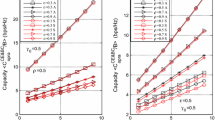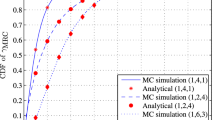Abstract
In this paper an approach to the performance analysis of signal-to-interference (SIR) based selection combining (SC) operating over the Rayleigh fading channels experiencing an arbitrary number of multiple, Rayleigh co-channel interferers is presented. We have presented a general analysis of multibranch SC where each branch experiences an arbitrary number of multiple equal power co-channel interferers. Useful closed form expressions are derived for the probability density function (PDF) and cumulative distribution function (CDF) at the output of the combiner. Also an outage analysis is performed in order to show the effects of the number of multiple interferers, diversity order and input SIR unbalance to the system performances.
Similar content being viewed by others
References
Stavroulakis, P. (2003). Interference analysis and reduction for wireless systems. London: Artech House.
Lee, W. C. Y. (2001). Mobile communications engineering. New York: McGraw-Hill.
Simon, M. K., & Alouini, M. S. (2005). Digital communication over fading channels, 2nd edn. New York: Wiley.
Stuber, G. L. (2003). Mobile communication (2nd edn.). Boston: Kluwer.
Sagias, N. C., Zogas, D. A., & Karagiannidis, G. K. (2005). Selection diversity receivers over non-identical Weibull fading channels. IEEE Transactions on Vehicular Technology, 54, 2146–2151.
Zogas, D. A., Karagiannidis, G. K., & Kotsopoulos, S. A. (2004). On the average output SNR in selection combining with three correlated branches over m-fading channels. IEEE Transactions on Wireless Communications, 3, 25–28.
Okui, S. (2000). Effects of SIR selection diversity with two correlated branches in the m-fading channel. IEEE Transactions on Communications, 48, 1631–1633.
Austin, D., & Stuber, L. (1995). In-service signal quality estimation for TDMA cellular systems. In Sixth IEEE international symposium on personal, indoor and mobile radio communications, PIMRC ’95, Toronto, ON, Canada (pp. 836–840).
Brandao, A., Lopez, L., & McLernon, C. (1994). Co-channel interference estimation for M-ary PSK modulated signals. IEEE Personal Communications, 1(1), 23–32.
Shah, A., & Haimovich, A. (1998). Performance analysis of optimum combining in wireless communications with Rayleigh fading and cochannel interference. IEEE Transactions on Communications, 46, 473–479.
Viler, E. (1999). Performance analysis of optimum combining with multiple interferers in flat Rayleigh fading. IEEE Transactions on Communications, 47, 1503–1509.
Abu-Dayya, A., & Beaulieu, N. (1991). Outage probabilities of cellular mobile radio systems with multiple Nakagami interferers. IEEE Transactions on Vehicular Technology, 40, 757–768.
Karagiannidis, G. (2003). Performance analysis of SIR-based dual selection diversity over correlated Nakagami-m fading channels. IEEE Transactions on Vehicular Technology, 52, 1207–1216.
Stefanović, M. et al. (2007). Performance analysis of system with selection combining over correlated Weibull fading channels in the presence of cochannel interference. AEÜ International Journal of Electronics and Communications, 62, 695–700.
Panić, S. et al. (2009). Performance analysis of selection combining diversity receiver over α−μ fading channels in the presence of co-channel interference. IET Communications, 3(11), 1769–1777.
Spalević, P., Panić, S. et al. (2010). SSC diversity receiver over correlated α−μ fading channels in the presence of co-channel interference. EURASIP Journal on Wireless Communications and Networking. doi:10.1155/2010/142392.
Spalevic, P., Sekulovic, N., Georgios, Z., & Mekic, E. (2009). Performance analysis of SIR-based triple selection diversity over correlated Weibull fading channels. Facta Universitatis. Series Electronics and Energetics, 23(1), 89–98.
Trigui, I. et al. (2009). Performance analysis of mobile radio systems over composite fading/shadowing channels with co-located interferences. IEEE Transactions on Wireless Communications, 8(7), 3449–3453.
Trigui, I. et al. (2009). Outage analysis of wireless systems over composite fading/shadowing channels with co-channel interferences. In Proceedings IEEE wireless communications and networking conference (WCNC 2009), Budapest, Hungary, 5–8 April.
Alouini, M., & Goldsmith, A. (1999). Area spectral efficiency of cellular mobile radio systems. IEEE Transactions on Vehicular Technology, 48(4), 1047–1065.
Kang, M., Alouini, M., & Yang, L. (2002). Outage probability and spectral efficiency of cellular mobile radio systems with smart antennas. IEEE Transactions on Vehicular Technology, 50, 1871–1877.
Bhaskar, V. (2009). Capacity evaluation for equal gain diversity schemes over Rayleigh fading channels. AEÜ International Journal of Electronics and Communications, 63, 235–240.
Jakes, W. (1994). Microwave mobile communications (2nd edn.). Piscataway: IEEE Press.
Gradshteyn, I., & Ryzhik, I. (1980). Tables of integrals, series, and products. New York: Academic Press.
Reig, J. (2007). Multivariate Nakagami-m distribution with constant correlation model. AEÜ International Journal of Electronics and Communications. doi:10.1016/j.aeue.2007.10.009.
Luo, J., & Zelder, J. (2000). A statistical simulation model for correlated Nakagami fading channels. In Proceedings of the international conference on communications technology: Vol. 2, Beijing, China (pp. 1680–1684).
Joarder, A., & Omer, M. (2008). Some statistical properties of a bivariate chi-square probability density function (Technical Report). King Fahd university of petroleum and minerals, no. 382.
Okechukwu, U., & Aalo, V. (1997). Performance of selection diversity system in correlated Nakagami fading. In Proc. IEEE Veh. Technol. Conf. (VTC’97) (pp. 1448–1492).
Karagiannidis, G. K., Zogas, D. A., & Kotsopoulos, S. A. (2003). On the multivariate Nakagami-m distribution with exponential correlation. IEEE Transactions on Communications, 51, 1240–1244.
Tan, T., & Bealueu, N. (1997). Infinite series representation of the bivariate Rayleigh and Nakagami-m distributions. IEEE Transactions on Communications, 45, 1159–1161.
Yao, Y. D., & Sheikh, A. U. H. (1990). Outage probability analysis for microcell mobile radio systems with cochannel interferers in Rician/Rayleigh fading environment. IEE Electronics Letters, 26(13), 864–866.
Iskander, C. D., & Mathiopoulos, P. T. (2002). Analytical level crossing rate and average fade duration in Nakagami fading channels. IEEE Transactions on Communications, 50(8), 1301–1309.
Alouini, M. S., & Goldsmith, A. (1999). Capacity of Rayleigh fading channels under different adaptive transmission and diversity techniques. IEEE Transactions on Vehicular Technology, 48(4), 1165–1181.
Author information
Authors and Affiliations
Corresponding author
Rights and permissions
About this article
Cite this article
Petrovic, I., Stefanovic, M., Spalevic, P. et al. Outage analysis of selection diversity over Rayleigh fading channels with multiple co-channel interferers. Telecommun Syst 52, 39–50 (2013). https://doi.org/10.1007/s11235-011-9438-z
Published:
Issue Date:
DOI: https://doi.org/10.1007/s11235-011-9438-z




